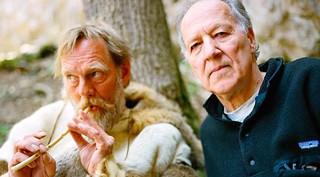I HAD A NIFTY COLUMN on the nation’s 235th birthday all ready to go for this Independence Day issue. It was awesome, I tell you.
And then I had to go see Werner Herzog’s Cave of Forgotten Dreams over the weekend, presented at Victory Square Cinemas by Tomasz Warchol of CineSavannah and Jim Reed of Psychotronic Films.
(Congratulations to the organizers on their sold-out screening.)
It put those 235 years in perspective, it did.
Herzog’s film is a look inside the recently discovered Chauvet Cave in France, which contains prehistoric wall paintings made over the past 32,000 years. Though in this case “prehistoric” almost doesn’t apply; the word might be “nonhistoric” or even “ahistoric.”
Sealed by a rock slide somewhere along the way, Chauvet Cave and its contents are amazingly well-preserved. Revealed in 1994, it represents the oldest art ever found — twice as old as anything else, in fact.
In an extremely rare opportunity, Herzog and a small crew were allowed inside with minimal equipment to make a record of the cave art, which the French government is taking enormous pains to preserve.
The crew’s battery-powered lights have an effect remarkably similar to the torches that the original artists would have used to light the cave’s interior.
The visual splendor of these skillfully rendered and deeply evocative paintings is stunning, both in their deceptive simplicity as well as in their raw power.
They are just as fresh today as they were on the day they were painted eons ago, when mammoths walked the earth and glaciers two miles thick covered much of the globe.
Many of us who saw the film were particularly struck by the same sequence, one that keeps coming back to us days later:
Narrating, director Herzog says carbon dating shows that a cave painter often made his or her own additions and embellishments 5,000 years after a painting was started.
Now that’s social media!
“We really cannot imagine 35,000 years ago,” Herzog intones. “There you can see a painting that was started by someone and completed by someone else 5,000 years later. We are bound in history and they are not.”
It’s quite profound and more than a little unsettling. It’s the rough equivalent of you stopping by a pyramid on your way to work to pay your respects to the pharaoh.
Much more profound than that, really, since these Neolithic artists had nothing like the concept of a modern nation-state. (Notice in this context ancient Egypt is “modern!” Wow.)
They made their own context. 5,000 years, 235 years... all the same to them.
So what does this have to do with the Fourth of July? Nothing. And everything.
This week we celebrate some deceptively simple handiwork of a different nature: The signatures of 56 men who put pen to paper to mark their unalterable commitment to the Declaration of Independence.
Theirs was a gamble which, though not made on the field of battle, had their very lives at stake just as if they were on the front lines.
The fighting would soon come in earnest, but on and around July 4, 1776 — some actually signed it later — their only weapons were their convictions and the quill pens they used to sign that sacred document.
The price of failure was death. There would be no do-overs. Unlike cave art and the amendable U.S. Constitution, no one could come along years later and make additions.
They were indeed “bound by history.” As are we.
America has grown larger and more powerful than the signers of the Declaration probably ever imagined, but also a good bit less independent than they likely wanted.
Our banks run the world but our government is on the edge of default.
Unrest in far-off countries makes gas here at home too expensive for our road trip.
Our soldiers fight for freedom in foreign lands, but some people within our own borders aren’t free to marry the person they love.
We can fly as we please, but before we board a plane our government presumes us to be terrorists unless we prove otherwise.
We are more bound by history than ever, but less bound to each other.
The original Tea Party slogan 235 years ago was “No taxation without representation.”
Today’s Tea Party just says “No taxation.”
Watching Cave of Forgotten Dreams, I got the deeply unsettling but also strangely uplifting sense that Neolithic painters thousands of years apart were the independent ones, having more in common with each other across the centuries than we do today in our giant bubble of cellphone and internet service, with so much to say to each other but so little of it really worth communicating.
And I was reminded again that politics, even a political statement as important as the Declaration of Independence, is still in the end about nothing but gaining and using power.
It is art and culture, not politics, which have the power to change people. And perhaps paradoxically, it is art and culture which also give us the power to find common ground, to find the sameness within us all.
It was always thus.
































